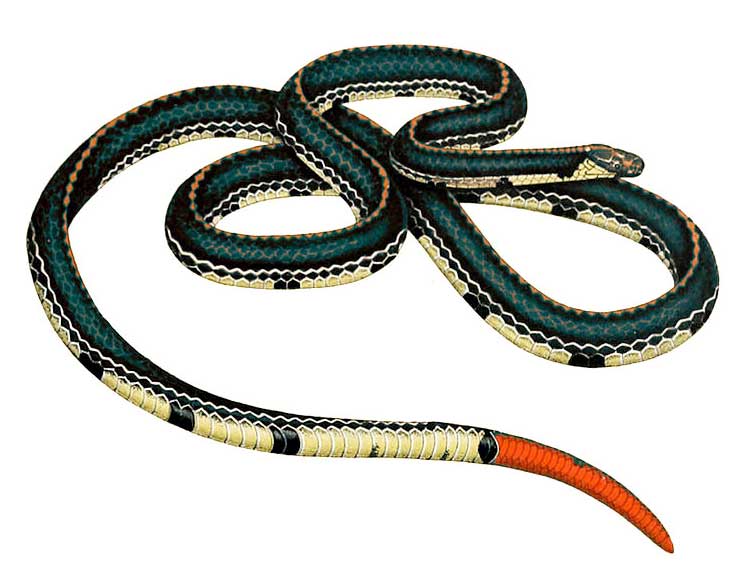
Calliophis bivirgatus (*)
Superregnum: Eukaryota
Regnum: Animalia
Subregnum: Eumetazoa
Cladus: Bilateria
Cladus: Nephrozoa
Superphylum: Deuterostomia
Phylum: Chordata
Cladus: Craniata
Subphylum: Vertebrata
Infraphylum: Gnathostomata
Superclassis: Tetrapoda
Cladus: Reptiliomorpha
Cladus: Amniota
Classis: Reptilia
Cladus: Eureptilia
Cladus: Romeriida
Subclassis: Diapsida
Cladus: Sauria
Infraclassis: Lepidosauromorpha
Superordo: Lepidosauria
Ordo: Squamata
Subordo: Serpentes
Infraordo: Caenophidia
Superfamilia: Elapoidea
Familia: Elapidae
Subfamilia: Elapinae
Genus: Calliophis
Species: Calliophis bivirgatus
Name
Calliophis bivirgatus (Boie, 1827)
References
Links
Uetz, P. & Hallermann, J. 2022. Calliophis bivirgatus. The Reptile Database. Accessed on 9 February 2020.
Grismer, L. & Chan-Ard, T. 2012. IUCN: Calliophis bivirgatus (Least Concern). The IUCN Red List of Threatened Species 2012: e.T191956A2020812. DOI: 10.2305/IUCN.UK.2012-1.RLTS.T191956A2020812.en
Vernacular names
English: Blue Malaysian Coral Snake
Calliophis bivirgatus is a species of snake in the family Elapidae known commonly as the blue coral snake[1] or blue Malayan coral snake.[2][3] It is native to Southeast Asia.[1]
Geographic range and distribution
This terrestrial snake occurs in Brunei, Indonesia, Malaysia, Singapore, Thailand,[1] and Burma.[3] It lives at 100 to 1,100 metres (300 to 3,600 ft) in elevation.[1]
There are three subspecies:[3]
C. b. bivirgatus – Indonesia
C. b. flaviceps – Indonesia, Malaysia, Thailand, Singapore, Burma
C. b. tetrataenia – Indonesia, Malaysia, Brunei
Description
This species was assigned to the new world coral snake genus Maticora until phylogenetic studies revealed this species to be nested within the tropical coral snake species clade Calliophis and sister species to Calliophis intestinalis, the banded Malaysian coral snake.[4]
This is a medium-sized coral snake with a slender body. The adult can reach 1.8 metres (5 ft 11 in) long. It has a red head, tail and belly. The back is dark blue to black in color, and it usually has a large blue[2] or white stripe on each flank.[5]
The snake, especially when juvenile, is often confused with the pink-headed reed snake (Calamaria schlegeli) as they share similar habitat and appearance. But the latter is much smaller, reaching a maximum length of 50 cm (20 in). The reed snake is nonvenomous, while the coral snake is potentially lethal.[2][3] They also are very similar to another venomous snake, the red-headed krait (Bungarus flaviceps).
Biology
This uncommon snake is considered semi-fossorial and is found in the leaf litter of primary and secondary forests.[1] It preys on other snakes. When threatened it usually flees, but it may remain in place with its red tail erect as a defensive message.[2]
Venom
Blue coral snake venom has only occasionally caused human deaths.[6] This species has unusually long venom glands, extending to 25% of the length of the body.[6] Unlike other snakes of the family Elapidae, its venom does not contain a neurotoxin.[6] The toxic element is instead a unique cytotoxin called calliotoxin[7] that causes near instantaneous paralysis by blocking the victims sodium channels. The venom also contains phosphodiesterases, which promote the release of adenosine, causing in turn hypotension, inflammation, and neurotransmitter blockade in prey items and other bite victims.[6] This ability is especially important as their prey consists mostly of other venomous snakes. There is no known antidote, though there is hope that the venom may eventually prove useful in the management of chronic pain in humans.[8]
See also
Ophiophagy
References
Grismer, L. & Chan-Ard, T. 2012. Calliophis bivirgata. The IUCN Red List of Threatened Species. Downloaded on 18 February 2016.
Calliophis bivirgatus. Ecologyasia. 2016.
Calliophis bivirgata. Reptile Database.
J. B. Slowinski, J. Boundy and R. Lawson. 2001. The phylogenetic relationships of Asian coral snakes (Elapidae: Calliophis and Maticora) based on morphological and molecular characters. Herpetologica 57(2) 233-245
Coral snakes: colors, bites, farts, and facts. Livescience. 16 December 2014.
Tan, C. H., et al. (2015). Unveiling the elusive and exotic: Venomics of the Malayan blue coral snake (Calliophis bivirgata flaviceps). Journal of Proteomics 132, 1.
Josh Hrala (1 November 2016). "Blue coral snake venom is ridiculously potent and causes instant paralysis". Business Insider.
"The Venom From This Beautiful Snake Will Murder You Horribly". ScienceAlert. ScienceAlert. Retrieved 29 July 2019.
Further reading
Boie F. 1827. "Bemerkungen über Merrem's Versuchs eines Systems der Amphibien. 1te Lieferung: Ophidier ". Isis von Oken 20: 508-566. (Elaps bivirgatus, p. 556).
Boulenger GA. 1896. Catalogue of the Snakes in the British Museum (Natural History). Volume III., Containing the Colubridæ (Opisthoglyphæ and Proteroglyphæ), ... London: Trustees of the British Museum (Natural History). (Taylor and FRancis, printers). xiv + 727 pp. + Plates I-XXV. (Doliophis bivirgatus, pp. 400–401).
Das I. 2006. A Photographic Guide to Snakes and Other Reptiles of Borneo. Sanibel Island, Florida: Ralph Curtis Books. 144 pp. ISBN 0-88359-061-1. (Calliophis bivirgata [sic], p. 61).
Oshea, Mark; Halliday, Tim; Metcalf, Jonathan (editor). 2002. Reptiles and Amphibians: Smithsonian Handbooks. London: DK (Dorling Kinderley). 256 pp. ISBN 9780789493934.
Retrieved from "http://en.wikipedia.org/"
All text is available under the terms of the GNU Free Documentation License

